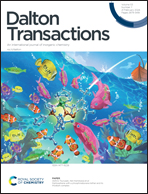Transferrin-inspired iron delivery across the cell membrane using [(L2Fe)2(μ-O)] (L = chlorquinaldol) to harness anticancer activity of ferroptosis†
Abstract
Although iron is a bio-essential metal, dysregulated iron acquisition and metabolism result in production of reactive oxygen species (ROS) due to the Fenton catalytic reaction, which activates ferroptotic cell death pathways. The lipophilic Fe(III)-chelator chlorquinaldol (L; i.e., 5,7-dichloro-8-hydroxy-2-methylquinoline) strongly favors the formation of a highly stable binuclear Fe(III) complex [(L2Fe)2(μ-O)] (1) that can mimic the function of the Fe(III)-transferrin complex in terms of the strong binding to Fe(III) and facile release of Fe(II) when the metal center is reduced. It should be noted that the cellular uptake of 1 is not transferrin receptor-mediated but enhanced by the high lipophilicity of chlorquinaldol. Once 1 is transported across the cell membrane, Fe(III) can be reduced by ferric reductase or other cellular antioxidants to be released as Fe(II), which triggers the Fenton catalytic reaction, thus harnessing the anticancer activity of iron. As the result, this transferrin-inspired iron-delivery strategy significantly reduces the cytotoxicity of 1 in normal human embryonic kidney cells (HEK 293) and the hemolytic activity of 1 in human red blood cells (hRBCs), giving rise to the unique tumor-specific anticancer activity of this Fe(III) complex.
![Graphical abstract: Transferrin-inspired iron delivery across the cell membrane using [(L2Fe)2(μ-O)] (L = chlorquinaldol) to harness anticancer activity of ferroptosis](/en/Image/Get?imageInfo.ImageType=GA&imageInfo.ImageIdentifier.ManuscriptID=D3DT02517A&imageInfo.ImageIdentifier.Year=2024)
- This article is part of the themed collection: Spotlight Collection: Bioinorganic Chemistry


 Please wait while we load your content...
Please wait while we load your content...